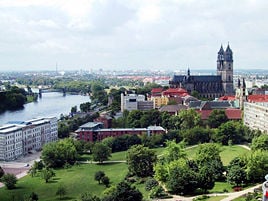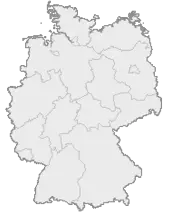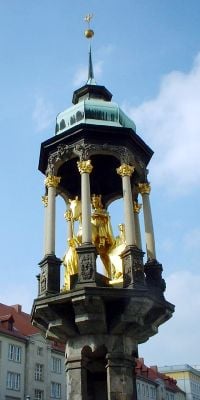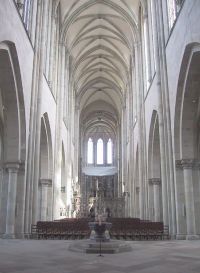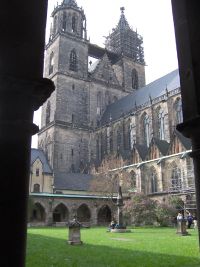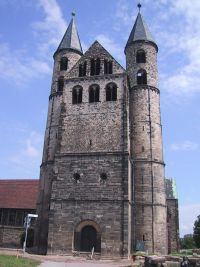Magdeburg
Magdeburg, the capital city of the Bundesland of Saxony-Anhalt, Germany, lies on the Elbe River and was one of the most important medieval cities of Europe. Emperor Otto I, the first Holy Roman Emperor lived during most of his reign in the town and was buried in the cathedral after his death. Magdeburg's version of German town law, known as Magdeburg rights, spread throughout Central and Eastern Europe. The city is also well-known for the 1631 Sack of Magdeburg, which hardened Protestant resistance during the Thirty Years' War. GeographyEconomyHistoryAlthough settlement on the site had existed for centuries, the city is first mentioned in the Diedenhof Capitulary as Magadoburg, dating to 805 C.E., by which the emperor Charlemagne had secured the small fishing and trading town. In 919 King Henry I the Fowler fortified it against the Magyars and Slavs. In 929 the city went to Edward the Elder's daughter Edith (Editha, Eadgyth) through her marriage with Henry's son Otto I, as a Morgengabe - a Germanic customary gift received by the new bride from the groom and his family after the wedding night. Editha had a particular love for the town and often lived there, and was buried in the abbey church crypt at her death. In 937 it was the seat of a royal assembly; the emperor also continually returned to it: he granted to the Benedictine abbey of Saint Maurice (later the cathedral) the secular tithes payable by Slavs taking refuge in three other fortresses and transferred to this his favourite foundation the bannus and the castlework services owed by the inhabitants of the surrounding countryside, which were his by imperial right. Later he was also buried in the cathedral. The Archbishopric of Magdeburg was founded in 968 at the synod of Ravenna, Adalbert of Magdeburg receiving consecration as its first archbishop. It included the bishoprics of Havelberg, Brandenburg, Merseburg, Meissen, and Zeitz-Naumburg. The archbishops played a preeminent role in the task of German colonization of the Slavic lands east of the Elbe river. In 1035 Magdeburg received a patent giving the city the right to hold trade exhibits and conventions, the basis of the later family of city laws known as Magdeburg rights. These laws were adopted and modified throughout Central and Eastern Europe. Many visitors from many countries begin to trade in Magdeburg. In 1118 a fire almost destroyed it.  Magdeburg's center has numerous Stalinist neo-classicist buildings. In the 13th century Magdeburg became a member of the Hanseatic League. Together with Brussels, Antwerp, Cologne, Nuremberg, Lübeck, Padua, Mantua, Cremona, Verona, Piacenza, Milan, Genoa, Florence, Metz and Strasbourg, Magdeburg was one of the cities with more than 20,000 inhabitants in the Holy Roman Empire. The town had an active maritime commerce on the west (towards Flanders), with the countries of the Baltic Sea, and maintained traffic and communication with the interior (for example Brunswick). The citizens constantly struggled against the archbishop, becoming nearly independent from him by the end of the 15th century. In 1524 Martin Luther was called to Magdeburg, where he preached and caused the city's defection from Catholicism. The Reformation had found speedy adherents in the city, where Luther had been a schoolboy. Emperor Charles V repeatedly outlawed the unruly town, which had joined the Alliance of Torgau and the Schmalkaldic League. Because it had not accepted the "Interim" (1548), the city, by the emperor's commands, was besieged (1550-1551) by the Elector Maurice of Saxony, but retained its independence. The rule of the Archbishop was replaced by that of various administrators, taken from Protestant dynasties. In the following years Magdeburg gained a reputation as a stronghold of Protestantism and becomes the first major city to publish the writings of Martin Luther. Matthias Flacius and his companions write their anti-Catholic pamphlets and the Magdeburg Centuries, in which they argued that the Roman Catholic Church had become the kingdom of Anti-Christ. In 1631, during the Thirty Years' War, imperial troops stormed the city and committed a massacre, killing about 20,000 inhabitants and burning the town in the sack of Magdeburg. The city had withstood a first siege in 1629 by Albrecht von Wallenstein. After the war only a population of 400 remained. According to the Peace of Westphalia (1648), Madgeburg was assigned to Brandenburg-Prussia after the death of the current administrator (a Saxon prince), as a semi-autonomous Duchy of Magdeburg; this occurred in 1680. In the course of the Napoleonic Wars, the fortress surrendered to French troops in 1806. The city was annexed to the French-controlled Kingdom of Westphalia. King Jérôme appointed Count Heinrich von Blumenthal Mayor (his statue still to be seen in the Nordpark). In 1815, after the Napoleonic Wars, Magdeburg was made the capital of the new Prussian Province of Saxony. In 1912 the old fortress was dismantled. Before World War II, Magdeburg was the seat of the German section of the Watchtower Society. During the war Magdeburg (then a city of about 340,000 inhabitants) suffered near total destruction from Allied firebombing. The impressive Gründerzeit suburbs north of the city, called the Nordfront, were destroyed as well as the city's main street with its Baroque buildings. It was the second most devastated city in Germany; only Dresden suffered more. American and Soviet troops occupied the city; however, the Americans soon left, leaving the city under Soviet stewardship. In the postwar years, many of the remaining pre-World War II city buildings were destroyed, with only a few buildings near the Cathedral restored to their pre-war state. Prior to Reunification, many surviving Gründerzeit buildings were left uninhabited and, after years of degradation, waiting for demolition. From 1949 on until German reunification on 3 October 1990, Magdeburg belonged to the German Democratic Republic. In 1990 Magdeburg became the capital of the new state of Saxony-Anhalt within reunified Germany. The city center was rebuilt almost exclusively in a modern style. One currency of Magdeburg is the local Urstromtaler (as well as the euro).[2] CathedralMagdeburg's most impressive building, the Cathedral of Saints Catherine and Maurice, has a height of 104 m: the highest church building of eastern Germany. It is notable for its beautiful and unique sculptures, especially the "Twelve Virgins" at the Northern Gate, the depictions of Otto I the Great and his wife Editha as well as the statues of St Maurice and St Catherine. The statue of St Maurice (ca. 1250) is one of the few where Maurice is displayed as a black man with African features holding a sword and wearing chainmail. This is surprising, in light of the fact that Maurice was an Egyptian. It is in fact the oldest depiction of a black person in Europe. St Catherine is dressed like a young teenage girl from the time of the statue's creation would have been - the equivalent to a girl in jeans and T-Shirt today. (Quite a scandal then.) The predecessor of the cathedral was a church built in 937 within an abbey, called St. Maurice. Emperor Otto I the Great was buried here beside his wife in 973. St. Maurice burnt to ashes in 1207. The exact location of that church remained unknown for a long time. The foundations were rediscovered in May 2003, revealing a building 80 m long and 41 m wide. The construction of the new church lasted 300 years. The cathedral of Saints Catherine and Maurice was the first Gothic church building of Germany. The completion of the steeples took place only in 1520. While the cathedral was virtually the only building to survive the massacres of the Thirty Years' War, it nevertheless suffered damage in World War II. It was soon rebuilt and completed in 1955. The place in front of the cathedral (sometimes called "new marketplace," Neuer Markt) was occupied by an imperial palace (Kaiserpfalz), which was destroyed in the fire of 1207. The stones of the ruin served for building the cathedral. The presumptive remains of the palace were excavated in the 1960s. Other sights
Magdeburg is one of the major towns along the Elbe Cycle Route (Elberadweg). Twin towns
People and CultureReferences
|
||||||||||||||||||||||||||||||||||||||||||||||
